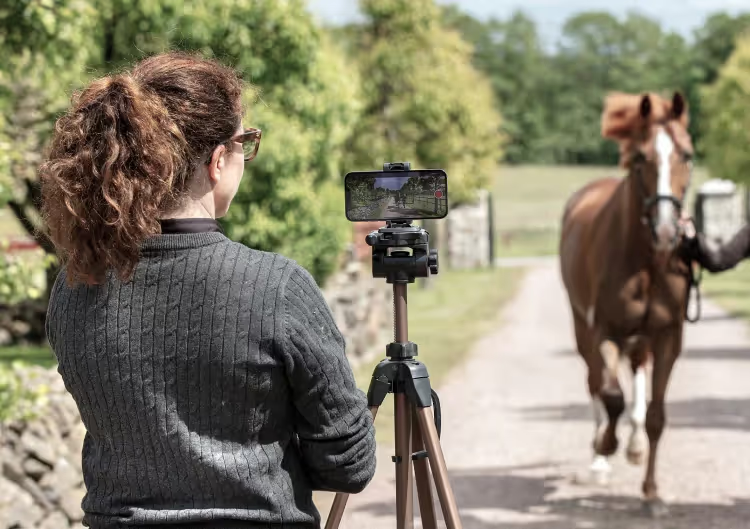
26 March 2024
Alongside established systems like MoCap and IMUs, recent breakthroughs have made objective gait analysis more accessible and easier to use — drawing on advances in computer vision, AI and smartphone technology to analyse movement directly from video.
This article compares three commonly used approaches to objective gait analysis: 3D Optical Motion Capture (MoCap), Inertial Measurement Unit (IMU) sensors, and Sleip’s video-based system.
The first objective gait analysis systems came from biomechanics research. Optical motion capture (MoCap), pioneered by companies like Qualisys, uses high-speed cameras and reflective markers placed on the horse’s body to track joint angles, limb movements, and symmetry in 3D. It remains the gold standard in research settings due to its precision and depth of data.
Many of the foundational studies in equine biomechanics have been carried out using MoCap, which continues to be the most accurate — though also the most technically demanding — of the available systems.
MoCap’s limitations in clinical practice — including cost, set-up complexity, and lack of portability — led to the development of more practical alternatives. IMU sensors are small wireless devices that attach directly to the horse’s body, measuring upper-body movement (head, withers, pelvis) through accelerometers, gyroscopes, and magnetometers.
IMU systems are more portable and affordable than MoCap, and so better suited to field use. However, reliable data depends on correct sensor placement and, in some systems, calibration — which can be time-consuming and operator-dependent.
Sleip’s system uses computer vision to track key points on the horse’s body from smartphone video, offering accurate, objective data without the need for markers or wearable sensors. Validated against MoCap with a precision of 2mm, Sleip is increasingly used in clinical and regulatory workflows as well as for research.
Designed for everyday use, Sleip enables clinicians to record high-quality video with a smartphone, and automatically analyses gait parameters via secure cloud processing. No specialised hardware is required, and vets can easily review videos alongside data, share findings, and follow progress over time.
Sleip is now widely used across equine practice. Vets use it in lameness exams to support diagnosis, treatment, communication, and case documentation. An adapted version of Sleip is available for other equine professionals. Trainers, physios and other professionals use it for longitudinal monitoring, to gauge the impact of training and interventions, as well as for early detection of potential lameness issues and referrals. In racing, it is increasingly adopted by competition organisers and regulatory vets as part of welfare protocols and pre-race assessments.
Unlike earlier solutions, Sleip can be used by multiple clinicians in parallel — with each analysis linked to synchronised video and available remotely. This supports collaborative care and helps practices scale objective data use across the team.
Each system has strengths depending on clinical and operational needs. MoCap remains the gold standard for research and highly detailed analysis but is often impractical for routine use. IMUs are more mobile but still require preparation, sensor placement and training.
Sleip stands out for its simplicity, flexibility, and multi-user design. With no physical setup, automatic updates, and built-in sharing tools, it supports seamless integration into everyday workflows. The ability to involve owners or external team members in follow-up care further extends its utility in modern equine practice. Sleip is not available directly for horse owners, but they can be invited to record by their vet.
AI-powered video analysis is now a recognised part of equine care, with growing adoption across disciplines. As new technologies emerge, trust and validation remain essential — especially when used to inform clinical decisions or regulatory protocols.
Sleip continues to evolve, with parameters like withers tracking and flagging of compensatory patterns, helping clinicians gain an even more complete picture of equine movement.
